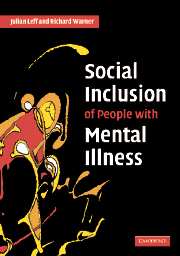Book contents
- Frontmatter
- Contents
- Preface
- 1 Introduction: barriers to social and occupational integration
- Part I The origins of stigma
- 2 The course of psychoses
- 3 The nature of stigma
- 4 Poverty and social disadvantage
- 5 Ameliorating users' symptoms
- 6 Dismantling psychiatric institutions
- 7 Reducing fear and discrimination among the public
- 8 Tackling self-stigmatisation
- Part II Overcoming obstacles to employment
- References
- Index
6 - Dismantling psychiatric institutions
from Part I - The origins of stigma
Published online by Cambridge University Press: 24 October 2009
- Frontmatter
- Contents
- Preface
- 1 Introduction: barriers to social and occupational integration
- Part I The origins of stigma
- 2 The course of psychoses
- 3 The nature of stigma
- 4 Poverty and social disadvantage
- 5 Ameliorating users' symptoms
- 6 Dismantling psychiatric institutions
- 7 Reducing fear and discrimination among the public
- 8 Tackling self-stigmatisation
- Part II Overcoming obstacles to employment
- References
- Index
Summary
The legacy of the past
We have argued that the old-style psychiatric hospital perpetuates the stigma of psychiatric illness by virtue of its original isolation from residential areas, its exclusion from general medical services, and the custodial practices that came to characterise the care offered within its walls. The great programme of asylum building took place in the nineteenth century as a response to concern about the quality of care received by mentally ill people in private madhouses or confined in ordinary private households. The number of mental hospitals in the UK rose from nine in 1827 to 77 in 1900 (Carrier and Kendall, 1997). Initially spurred by humanitarian motives, the programme involved careful attention to the design of the hospitals, including the efficient circulation of air. The living spaces were large, with high ceilings and plenty of room for recreational activities. Airing courts were provided to enable the patients to exercise regularly.
It was the policy to site the hospitals in the countryside some miles from the nearest conurbation. This impeded visiting by relatives and friends, although in the case of Friern Barnet hospital, built some eight miles beyond the limit of Victorian London, the railway line was extended to reach the hospital. Unfortunately, once they were opened, the hospitals rapidly filled up with patients to well beyond their planned capacity. Friern Barnet hospital was built for 1000 patients and opened in 1851. The peak bed occupancy of 2400 was reached 100 years later.
- Type
- Chapter
- Information
- Social Inclusion of People with Mental Illness , pp. 63 - 75Publisher: Cambridge University PressPrint publication year: 2006



